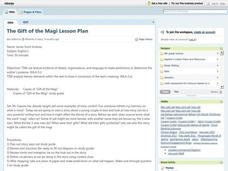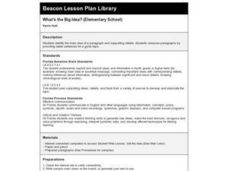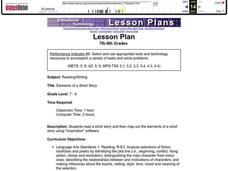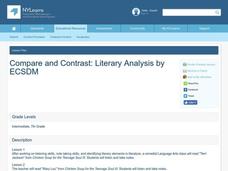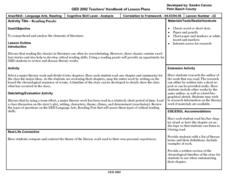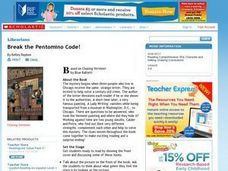Curated OER
Plot Summary for Story Element
Seventh graders identify story elements utilizing a plot summary organizer. In this story elements lesson, 7th graders discuss the elements of a good story. Students use The Three Little Pigs to practice finding the plot elements....
Curated OER
Plot Summary for Story Elements
Ninth graders identify story elements utilizing a plot summary organizer. In this plot summary activity, 9th graders discuss the elements of a good story and listen to the story of the three little pigs. Students complete a group plot...
Curated OER
The Gift of the Magi
Test the true meaning of giving - and irony - with this lesson about "The Gift of the Magi." Using textual analysis, details, and text organization, middle schoolers make predictions about future events in the story and determine the...
Curated OER
What's the Big Idea
Discuss the concept of main idea in a story or other reading material. Middle schoolers identify the main idea in a passage using a technique that eliminates unnecessary words not relevant to the main idea.
Curated OER
Elements of a Short Story
Students read a short story, The Tell-Tale Heart and create a story map identifying the elements of a short story included in the selection. Students complete an Accelerated Reader test on the selection.
Curated OER
Compare and Contrast: Literary Analysis
Great for a reading intervention or remedial Language Arts class, this lesson plan uses two stories from Chicken Soup for the Teenage Soul III ("Terri Jackson" and "Mary Lou" to reinforce note-taking skills, story elements, and comparing...
Prestwick House
Star Wars and the Hero's Journey
Is Luke Skywalker the archetype of a literary hero? Follow the path of the Hero's Journey with an engaging lesson that details the plot structure, applies it to Star Wars: A New Hope, and invites class members to choose their own...
Curated OER
Compare and Contrast: Literary Analysis
Seventh graders are able to use active listening skills, take notes and identify literary elements of a short story. They use/create graphic organizer, compare/contrast literary elements from various stories and compare and contrast traits.
Curated OER
Reading Puzzle
Twelfth graders examine the elements of literature. They each read a chapter of a novel, sequentially list the main ideas, present a summary of the chapter to the class, sequence the events, and review the novel by summarizing the timeline.
Curated OER
Mitty Test and Theme
Students read stories and determine the stock characterization, static/dynamic characterization and direct/indirect characterization. They read the story of "Mitty Test, "answer questions regarding the story, and discuss the themes of...
Curated OER
Extreme Poetry Vocabulary
Challenge your class with this comprehensive list of literary vocabulary words. Learners take a pre-test, look up definitions, come up with an example, and then take a post-test. You might use this prior to a unit about poetic devices in...
Curated OER
Wrapped in Mystery
Sixth graders can identify five basic elements that most mysteries contain. They put the elements of mystery into a graphic organizer they can follow. They construct meaning after reading Poe's short story and identify or infer the...
Curated OER
Break the Pentomino Code!
Pupils read and analyze the book, Chasing Vermeer. They discuss the main story elements, analyze how pentominoes are important to the story, use a pentomino code to decipher a message, and create a secret code of their own.
Bright Hub Education
The Winter of Our Discontent
The resource gives some basic concepts concerning the title of the novel, basic literary elements, student developed assessments, and a philosophical notion concerning honesty in literature. The instructors are shown where they can...
Curated OER
Camera Movement
Students focus on different ways director and cinematographers use the camera to convey meaning, setting, tone, point of view, personal style, as well as telling a story.
Curated OER
I Heard the Owl Call My Name
Tenth graders read I Heard the Owl Call My Name by Margaret Craven. They share interpretations and conclusions in either oral or written form. They deliver a speech that conveys information using clear and concise language.




